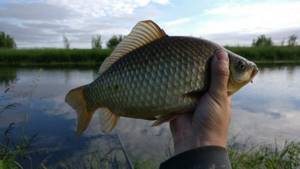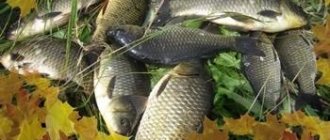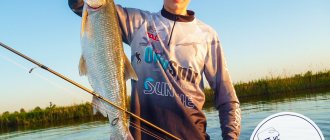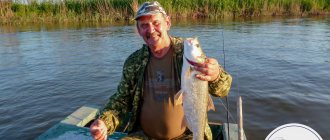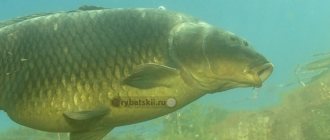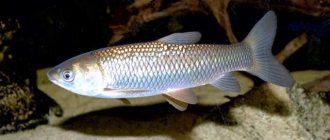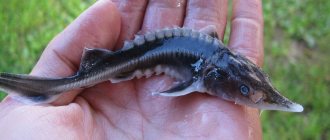general description
You can catch crucian carp with a fishing rod almost anywhere. This fish does not grow in large quantities (especially silver crucian carp); an average crucian carp is measured with the palm of an adult. This species is unpretentious to oxygen saturation - it is also satisfied with completely musty reservoirs.
The only thing he doesn’t like in water is fast currents. On rivers it is worth looking for it in creeks, backwaters, and bends.
If there are no competitors in the reservoir (in the form of harrier or rudd), crucian carp bites on any bait greedily and actively. But it does not grow to large sizes in such water areas. Oddly enough, trophy specimens are found where predatory fish are found in abundance.
The maximum age of this fish is 12 years. The maximum weight it can reach is 5 kg.
Fishing time
The most controversial way to overcome lack of bite. Each reservoir has its own schedule for crucian carp. Any angler unfamiliar with the crucian schedule can fall into a “pause” between the crucian bite. But crucian carp can bite not only at dawn and dusk. In some reservoirs, fish can only feed at dusk. And in others, the bite is just beginning at noon. Therefore, sometimes it is worth not giving up, but waiting.
Experience comes with age. Any body of water has to be studied for a long time and painstakingly. If an angler manages to understand the behavior of crucian carp in a particular body of water, the angler will always have a catch.
Lyavzin Anton Anatolyevich - Specially for the site SamodelkiFISH, Belarus, Pruzhany
- Bait for catching large crucian carp
- Choosing gear for catching crucian carp depending on the type of bottom of the reservoir
Kinds
Crucian carp is found in gold and silver , so it is called by the color of its scales. The features of the subspecies are as follows:
- golden crucian carp has a thickened appearance, covered with brown scales with copper shades; capable of growing up to 50 cm in length with a weight of up to 5 kg;
- silver crucian carp has a more elongated body, may have a greenish tint, grows no more than 12 cm in length and weighs about 3 kg at its maximum.
Both species can coexist in the same body of water without interfering with each other.
Fishing for crucian carp - About bait
Ask any angler with knowledge of how to properly catch crucian carp, and I guarantee that he will point out to you the importance of properly feeding the area. Indeed, without good bait, you will not be able to catch many fish, and I think you understand why.
The most common problem that anglers face is overfeeding their fish. The crucian carp quickly becomes saturated with bait and leaves for its parking place.
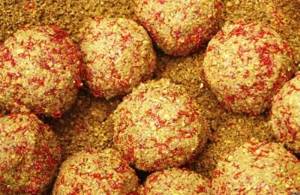
A wise fisherman knows that it is better to underfeed the fish than to give it plenty to eat.
Overfeeding crucian carp is associated not so much with the amount of bait as with its calorie content.
With nourishing mixtures made on the basis of porridges, crucian carp eats up very quickly.
A good bait for crucian carp should not contain high-calorie components, the fraction should be small. Therefore, experienced fishermen prefer to feed crucian carp with mixtures intended for silver bream and roach. I advise you to follow their example.
If in the reservoir where you will be fishing, crucian carp clearly prefers food of animal origin, and you catch it with maggots or worms, you need to add animal components to the bait. This could be food bloodworms, small maggots, or pieces of crawling or dung worms.
It is known that crucian carp, like any carp fish, are very attracted to various pleasant smells. The hero of this article loves fragrances:
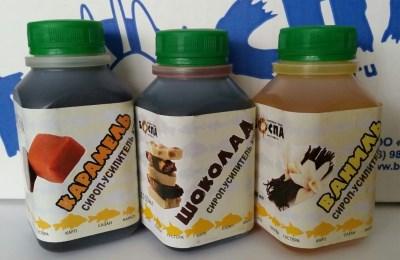
Anise.- Strawberries.
- Honey.
- Vanilla.
- Carnations.
- Sunflower cake.
- Hemp.
Knowing the preferences of crucian carp, fishermen add flavorings to the bait. Natural and synthetic flavors can be used. Natural flavors are powdered vanillin, anise oil, ground hemp or crushed sunflower cake.
Synthetic fragrances have the same odors as natural ones, but are only sold in the form of oils, drops and sprays. They contain the necessary extracts and odor enhancers.
Nutrition
Despite the fact that this fish is considered omnivorous, the diet of crucian carp has its own characteristics:
- the fry usually feed on daphnia and small algae;
- later their diet includes bloodworms and insect larvae;
- adults love small crustaceans and larvae;
- Crucian carp is very attached to duckweed.
Crucian carp is a fish with a very developed sense of smell , so it can sense food or bait that falls into the water at a fairly long distance.
Reasons for the low activity of crucian carp
This fish, especially large specimens, is one of the most weather-sensitive in fresh waters. It is worth understanding that fish in a pond do not live according to a schedule all year round. Yes, fishermen note periods when crucian carp throughout the reservoir begin to bite at a certain time, but this does not always happen. It is enough for the temperature to drop or the pressure to change or the water level to drop literally by centimeters, and there may be no bite at all that day.
Sometimes a fisherman may encounter a situation where a passive crucian carp suddenly transforms for a short time and begins to grab any bait offered to it.
In river fishing, there is an unspoken rule among float lovers: “If the fish doesn’t bite for more than an hour, you need to look for another place.” On any body of water there are always places where this or that fish is active, where hungry fish stand, where they bite.
Most of us fishermen understand little about the science of ichthyology. But the behavior of fish, in addition to weather conditions, is influenced by many factors hidden from us behind the transparent surface of the water. Beneath the surface of the water, there are processes going on, sometimes unnoticeable, that affect biting activity.
Spawning
The ability to reproduce in this inhabitant of lakes and rivers occurs at approximately 3-4 years of age. The beginning of spawning is highly dependent on weather conditions and is not tied to a specific date.
Expert opinion
Knipovich Nikolai Mikhailovich
Zoologist, hydrobiologist. I am interested in fishing at a professional level.
Important! The main condition for the start of spawning of crucian carp is a steady warming of the water to 17-18 degrees. If the water remains cold, this fish will not spawn even in early summer.
If the temperature regime is observed, spawning of crucian carp usually begins in late May - early June.
The process occurs several times, in periods, the intervals between them usually last from a week to 10 calendar days.
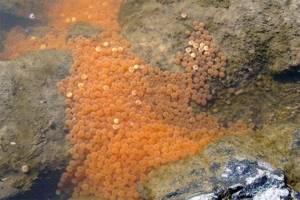
The eggs of these fish are sticky. It holds well on any underwater vegetation even in the presence of a current. The female is capable of laying about 400 eggs and even more. The incubation period takes up to a week, again, a lot depends on the water temperature.
Female silver crucian carp, in the absence of males in the reservoir, can fertilize eggs with the milk of other similar species. But then only female fry are born.
Of course, during spawning, crucian carp, like most other fish, practically does not bite, it is useless to catch it, but immediately before spawning and immediately after it, the fish are actively saturated and rush to almost any bait.
Features of catching crucian carp at different times of the year
At different times of the year, fishing for crucian carp will differ in some nuances. Let's look at the features of catching this fish in different seasons.
Fishing in winter
Winter fishing for crucian carp begins with the arrival of the first severe frosts and the formation of good ice cover on reservoirs. In February, during the thaw, you can also enjoy quite frisky bites.

In order for the fishing to be successful, several nuances should be taken into account:
- The most suitable for winter fishing are reservoirs with a sandy bottom;
- in ponds with muddy and peaty bottoms, crucian carp are not caught in winter, with the exception of schools lying in settled grass and silt;
- you can expect a good bite in reservoirs with predatory fish;
- Wintering holes and small edges are considered successful for fishing.
Tackle and equipment for fishing in winter are as follows:
- float rod or jig;
- invisible thin line up to 0.12 mm;
- hook number 2.5;
- The load on the float tackle should be light.
Before you start fishing, prepare your tackle well. The float should sink slowly; sometimes a plastic or metal nod is used instead. When selecting a jig, it is better to choose a black ant, a pellet with a diameter of 4 mm, or a small lentil.
Familiarize yourself with the features of catching crucian carp using corn.
Bloodworms should be used as bait. The nozzle should not lie on the bottom, but only lightly touch it, being 2–3 cm from its surface.
Spring fishing
Hunting for trophy crucian carp in the spring can begin from the first days of ice melting from the river. At this time, the water is actively saturated with oxygen, aquatic plants resume their growth, and small inhabitants of reservoirs come to life. The fish begins to actively feed and move around in search of food. Fishing with float tackle is not relevant at this time; the best results can be achieved when fishing with an elastic band.
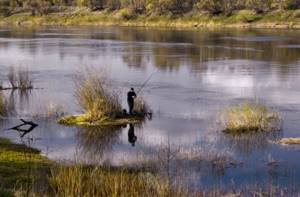
This is a fairly simple tackle that can be assembled in a few simple steps:
- Tie a weight to a short length of rope.
- Attach a piece of aircraft model rubber at least 5 m long to the load (maximum length can reach 20 m).
- Fix from 5 to 7 leashes with a length of 10 to 30 cm on a five-meter piece of fishing line. Attach hooks numbered 5, 6 or 7 to the leashes.
- As a fishing rod, you can take a small spinning rod with a reel or a board for winding fishing line. The thickness of the main line can vary from 0.4 to 0.5 mm.
This type of gear works well both from the shore and from a boat. Spring bites can be expected in shallow, quickly warming areas of the reservoir.
Also read about how to prepare wheat for crucian carp fishing.
It is better to choose bait of animal origin as bait at this time:
- bloodworm;
- maggot;
- earthworms and dung worms.
In early May, crucian carp begin to spawn. It lasts from 4 to 7 days, the duration depends on weather conditions, the depth of the reservoir and its features. At this time, the bite stops; after the specified period of time, the bite is possible, but the fish that will be caught are small and spawned.
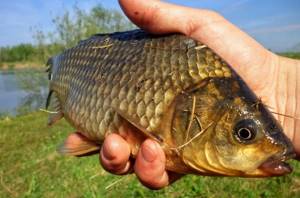
Fishing in summer
Summer is considered the best time to catch crucian carp. Active biting can begin at sunrise and last almost until midnight. The crucian carp rests for 3–4 hours at lunchtime. At this time, it is better to use a float rod; large fish can be caught before sunrise. The “elastic band” remains relevant in shallow water; you can still catch heavy crucian carp with such tackle. An important factor for successful fishing in the summer is abundant complementary feeding.
Basic rules for catching crucian carp
At each time of the year, crucian carp, like many other fish, behaves differently. But still, there are basic rules for catching it, which remain unchanged throughout the year:
- the best time to catch this fish is early morning and evening;
- large specimens are usually hooked after sunset;
- It is preferable to carry out float fishing in thickets of reeds or other algae;
- the best baits: worm, bread crumb, semolina;
- Sometimes large individuals may covet pieces of small fish.
in spring
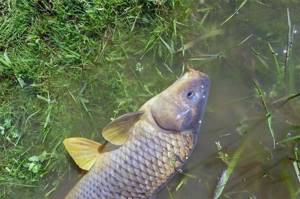
The temperature conditions when the spring bite of crucian carp begins have already been mentioned. In spring, this fish prefers to go to shallow water, where the water temperature is higher, and where you can find the remains of algae, small larvae and insects that have fallen into the water. This is where you should lie in wait for the crucian carp.
Active biting begins in the spring when the reservoir warms up to 12-15 degrees and continues until spawning. Then the activity subsides; the most successful spring fishing for this species occurs after spawning.
In summer
Until approximately mid-June, crucian carp do not show much activity if spawning is delayed for some reason. During this period, only small individuals that have not reached puberty become prey for the fisherman.
Then comes the time for a stable bite. It should, however, be noted that it is rarely as active as the spring one, since the reservoirs already have a lot of plant and other protein foods, which the crucian carp eats with pleasure.
But if you have good bait and appetizing complementary food, this food-hungry fish will definitely get hooked.
Expert opinion
Knipovich Nikolai Mikhailovich
Zoologist, hydrobiologist. I am interested in fishing at a professional level.
Important! It should, however, be borne in mind that crucian carp are very sensitive to weather changes. Any signs of approaching bad weather or a drop in air temperature can leave you without a catch, even where fish have always been caught before.
In summer, especially on hot days, crucian carp look for cool places. At this time, he often approaches the shore, in shady places. The bite is better there in the summer.
But in water with a lot of floating small algae, you shouldn’t look for it. The crucian carp leaves from there due to the low oxygen content.
in autumn
In the autumn months, the water temperature gradually decreases, and the behavior of crucian carp also changes. It becomes less mobile and looks for deep-sea places where it can stand for a long time. It is already rare in catchable summer places in shallow water.
In autumn, active biting of crucian carp can be observed before the weather changes: cold weather, rain, the first snow. The fish senses the approach of winter and accumulates fat reserves.
If you are lucky enough to find a place where a school of crucian carp is standing in a hole, you can have a good catch until the freeze-up.
Other factors
In addition to the above factors, the bite of crucian carp can also be influenced by the composition of the local ichthyofauna . Or more precisely, the presence of food competitors in it. If there are any, the crucian carp will behave noticeably more actively than in those reservoirs where only it lives.
If there are predators in a reservoir , they force the crucian carp to “live on the run,” that is, to constantly waste energy. To replenish it, the fish need to eat more. This also has a positive effect on the bite. But in reservoirs where there are no predators, crucian carp are “lazy.” And noticeably less active.
Composition of water . First of all, the percentage of dissolved oxygen in it. If the reservoir is not at all stagnant, but is completely renewed by clean tributaries or springs, this circumstance only has a beneficial effect on the activity of crucian carp. Also, water can be hard or soft, and contain organic impurities - this affects how quickly and in what volumes single-celled algae will develop in it. And therefore - how intensely it will “bloom”, which again affects the oxygen regime.
Finally, the activity of crucian carp directly depends on the food supply . I have already hinted at this more than once above, but now I say it directly - the poorer it is, the more active the crucian carp is, but accordingly, the less well-fed it is.
Collection of fishing gear
crucian carp killer
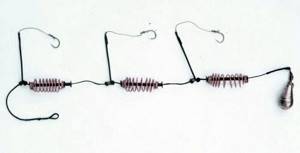
This tackle got its formidable name due to the fact that its design is made in such a way that the crucian carp has practically no chance of freeing itself after swallowing the bait.
The essence of the gear is very simple. A sinker and successively several spring feeders are attached to the end of the fishing line, each of which has a leash with a hook attached. Various versions of this design are sold in stores, but it is not very difficult to make it yourself.
The principle of operation of this fishing device is reminiscent of feeder fishing, only there are usually 3 feeders, and they are located on the main line, and not on a separate leash.
The design allows you to catch not only crucian carp; often carp and even bream are caught on it.
The disadvantages of the gear include the difficulty of casting, the noise that such a cast makes, and the low visibility of the bite. In addition, it should be used for long casts, since fishing near the shore will be ruined by small fish.
Float rod
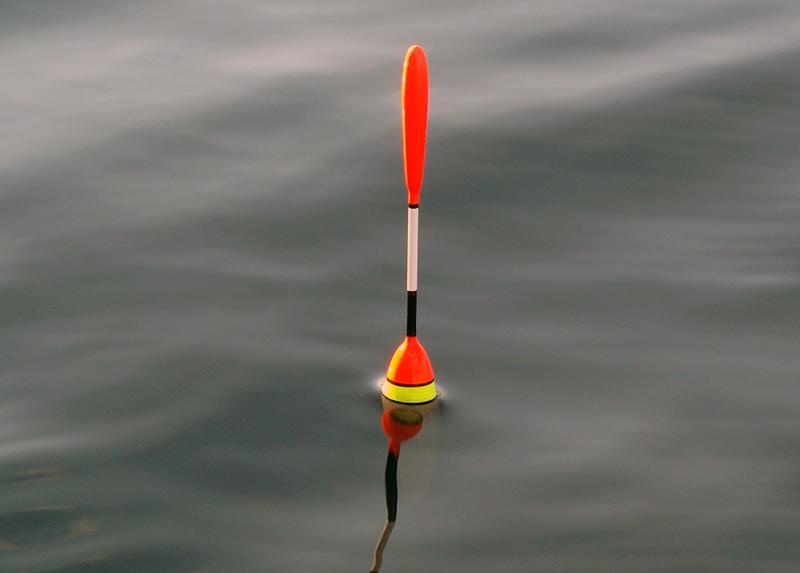
The most common type of gear used to catch fish of this species. True, supporters of the bottom design, such as the crucian killer, argue that it is the bottom options that allow you to catch large specimens, but this is a very controversial issue.
Fishing for crucian carp with a float rod gives the fisherman true pleasure. There is nothing to compare the characteristic bite of this fish, when the float first trembles slightly, and then lies down and moves to the side. Here the catch needs to be hooked in time. And not only because he can get off the hook, it doesn't happen that often. Fishing for crucian carp is usually carried out in places with dense vegetation; the fish caught there can take away the tackle, then snagging or tangling of the fishing line is almost inevitable.
They catch crucian carp using a regular Bolognese telescopic fishing rod. But swing options are also possible.
Floats are usually used thin, sliding, with great sensitivity. Sinkers, like hooks, are also recommended to be used in small sizes.
Donka
Bottom tackle for crucian carp differs little from the bottom tackle, which is used for other types of fish. It is a sinker on the main line. from which leashes with hooks extend. The classic version does not allow other additions; they will be discussed later.
Catching gear for large, deep reservoirs with a flat bottom.
Significant disadvantages of donkey include the need for clean water in the place where it is cast and reeled in, otherwise breaks and entanglements will ruin the whole fishing.
Many fishermen pre-clear the bottom fishing area of vegetation, but this should be done in advance. Crucian carp is a shy and cautious fish. Manipulations in the water can alarm him so much that he will leave this place for a long time.
Feeder
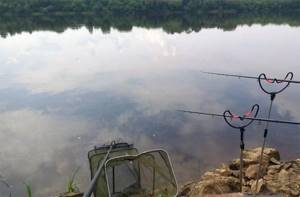
Feeder gear was invented for carp fishing, but it is also quite suitable for crucian carp. The principle of fishing with a feeder is simple, but quite effective. Using a special feeder rod, both a leash with a hook and a feeder with bait are thrown into the water at the same time. Initially, you can throw one feeder with starter food to attract fish. The feeder, by the way, also serves as a sinker, which lowers the entire structure to the bottom.
A bite is indicated by a special tip at the end of the rod, which is called the tip. The tips are removable, they can be changed depending on the fishing conditions and the size of the expected trophies.
The disadvantages of feeder gear include a certain difficulty in casting, the mandatory presence of a special fishing rod and frequent tangling of the gear if the design is not made entirely correctly.
Pacifier
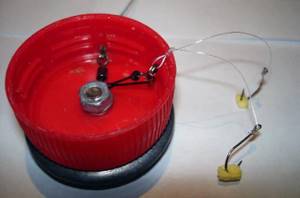
Now this original tackle can be purchased in stores, but many fishermen make it themselves, it’s not difficult.
It is enough to take an ordinary cap from a plastic bottle, preferably with a wide neck, attach a lead plate to it as a weight, and tie several leashes with hooks to the edges of the cork.
Now the inside of the cork is filled with bait, and hooks with bait are embedded in the bait.
The crucian carp is attracted by the aroma of the bait and the turbidity rising from it; it approaches the plug thrown into the water with the help of a rod, begins to suck in the bait and inevitably swallows the hooks. Then it cuts itself.
Some fishermen even use small foam balls as bait, the main thing is that the crucian carp does not feel the hook at first.
Other fish can also be actively caught on a nipple or plug, it all depends on the composition of the bait.
Makushatnik
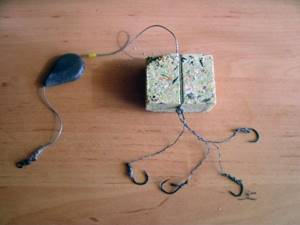
Catching crucian carp on the top is an ancient fishing method that was actively used by our grandfathers and great-grandfathers. Now he is not very popular, and in vain. This kind of fishing does not require much physical or material expenditure.
Makukha is a briquette of waste that appears from the production of sunflower oil. This is also called cake . Such cake can be easily purchased today in every fishing store. It is usually sold in the form of large circles or briquettes. From this amount you should cut (do not break, as everything will crumble) into small briquettes measuring approximately 4 by 5 cm.
Now they can be attached to a steel plate of similar size using, for example, rubber bands. The main fishing line and hooks with leashes are attached to the plate by rings.
Then, as in a nipple, the hooks are recessed into the top of the head. The tackle is ready.
To cast it, they usually use a feeder rod (it is stronger than usual) or even cast the tackle like a donkey. Once in the water, the cake will immediately begin to spread an odor that is attractive to crucian carp throughout the water area. The crucian carp will discover it and begin to suck in fragments of the top along with the hooks.
The only drawback of the makushatnik is that on a muddy bottom it can drown in silt, and the fish simply will not notice it, and the cake will not be washed away.
Spring
We have already talked about crucian carp killer gear, when several feeder springs are used at once. You can use one. It is more convenient and faster to manufacture.
Hooked leashes are usually attached to the feeder itself or to the main line that runs through it. The last option is called sliding; the stopper on the line can be set at a certain distance. Then the crucian carp, swallowing the bait with a hook, will not immediately feel any resistance and will hook itself after a while when trying to swim away.
Rubber
Catching crucian carp with a rubber shock absorber is quite popular today. However, not everyone is satisfied with the somewhat cumbersome design and the relative complexity of the initial casting.
Making gear is not difficult. An elastic band is tied very tightly to the sinker (which must be heavy). And at the other end there is a fishing line with leashes and hooks. It is enough to throw such a structure once in the right place, so that you can then pull it ashore only with a fishing line and leashes during a bite.
You remove the fish from the hook, release the line, and the elastic band tightens again and sends the bait back to its original place.
Installation features:
- all structural elements must be tied to each other very securely;
- the elastic band should stretch at least 3 times;
- It is better to choose a round cross-section; a rectangular one quickly wears out and breaks;
- For a sinker, you can use a railroad spike or half a brick.
Tackle used
Fishing usually takes place using a float rod or donkey.
The fishing rod is used when catching small and medium-sized crucian carp, while the donka is thrown onto large fish.
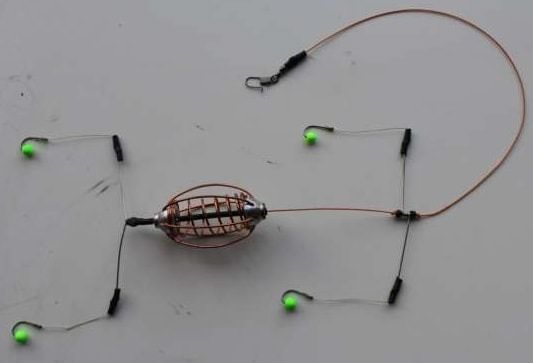
Bottom tackle
In general, the type of gear used directly depends on the season: in the spring, he is perfectly caught with a float rod, since after hibernation he gets hungry and grabs almost indiscriminately any bait. The advantage of the donkey is that it allows you to fish at great depths or at a considerable distance from the shore.
What do crucian carp bite on?
Some consider crucian carp to be an omnivorous fish. This is partly true, but still the catchability of a particular bait depends on the fishing conditions, time of year and characteristics of the reservoir.
Plant attachments
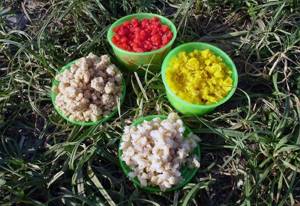
Crucian carp switches quite safely to plant baits in the summer. There is a lot of such protein food in the reservoir at this time of year, it is easy to get, and you don’t have to migrate for a long time. Experienced fishermen say that this fish can even peck on pieces of reeds in the summer.
The main vegetable baits when fishing for crucian carp are:
- semolina chatter; crucian carp really loves this bait; It is noteworthy that you can prepare it from a small amount right on the shore, using local water;
- boiled pearl barley; This is also a very tasty dish for the type described; after cooking, it is better to leave it in a thermos, adding a little sugar and salt; some fishermen advise adding a little honey to it;
- steamed wheat; You can also use millet cereals; when boiled, they make a very easy-to-make dough;
- steamed peas; Some enthusiasts generally claim that this particular bait for crucian carp is the most effective. Only legumes should be used whole, not crushed;
- boiled corn , you can also use canned corn;
- dough with flavors and additives;
- just bread , preferably a loaf.
Animal origin
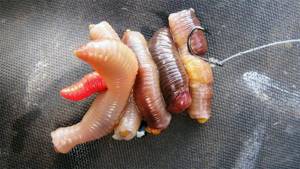
In the spring, crucian carp bite well on maggots, bloodworms, or a combination of these elements. You can use cockchafer or dragonfly larvae, this is just in season.
In summer, preference is given to worms, maggots and larvae. They bite on bloodworms only in June. Then he stops paying attention to him altogether. The fact is that under natural conditions bloodworms are almost never found after June. And in nutritional value it is inferior even to plant food.
Closer to autumn, crucian carp are attracted by worms, underleaves, and crawlings. He willingly pecks at large larvae - protein animal food is just in place for cold weather.
Crucian carp can peck at the red worm until the freeze-up.
Artificial bait
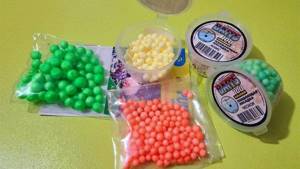
They are usually used in the spring during the period of rapid activity of crucian carp. At other times of the year, artificial baits are supposed to be used for predatory fish species.
The most effective artificial bait is colored foam balls. If you also provide them with flavoring, a good catch is quite possible.
Some spinners manage to catch crucian carp using silicone larvae. Only the wiring technique should be slow, with numerous stops. Crucian carp is a slow and calm fish. He will not chase a fast larva; he likes almost motionless prey.
Weather and bite
Of course, there are many factors that influence why crucian carp refuses to bite. But the most common reasons for the lack of bite are unfavorable weather conditions. The activity of fish and its appetite are negatively affected by the following:
- high air temperature (more than 27°C);
- changes in atmospheric pressure;
- sudden cold or warming;
- strong wind;
- hot sunny weather.
When the street is warm, cloudy and there is a slight wind, catching a couple of crucian carp will not be difficult even for a beginner. But in the heat and during sudden changes in weather, which happens quite often in June and July, the fish are not active. This is due to changes in the oxygen regime in the water and different pressure on the swim bladder. Crucian carp either go to greater depths or swim in the upper layers, completely ignoring the bait at the bottom.
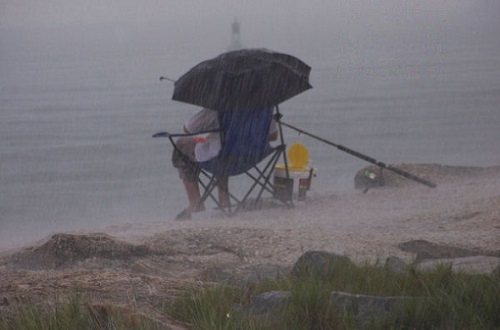
Weather conditions have a great influence on the bite of crucian carp
Strong wind also negatively affects the bite - it creates a large wave and thereby scares the fish. If there is a slight drizzle or there are ripples on the water, then the chances of a good catch increase sharply. This is again explained by the oxygen content. Small waves and bubbles from raindrops falling into the water significantly increase the oxygen concentration, which contributes to the activity of crucian carp in searching for food.
Groundbaits and lures
When choosing bait in a store or making it yourself, be guided by the following principles:
- large crucian carp are attracted to large fractions, small things will be collected into dust;
- the warmer the water, the more flavorings should be in the composition;
- in shallow water, the bait should disintegrate quickly, but... Let's say, for the pacifier you need to use viscous options;
- pay attention to color; The bright color of the complementary food scares away the wary crucian carp.
Purchased
There are several very attractive baits specifically for crucian carp:
- Traper secret tench crucian carp; this option is considered perhaps the best mixture in overgrown reservoirs;
- Marcel Van Den Eynde Feeder – catchable feeder bait;
- Gf Crucian carp is just a good all-rounder;
- Fish.ka Crucian carp is considered the best Russian-made bait for this type of fish.
Homemade
It’s rare that a fisherman will resist the temptation to make his own bait and bait.
Expert opinion
Knipovich Nikolai Mikhailovich
Zoologist, hydrobiologist. I am interested in fishing at a professional level.
Important! It is necessary to distinguish between bait and bait; these are not synonyms. The bait is thrown to the fishing site for several days to accustom the fish to a certain place. The bait can be based on whatever the fish eats. And the bait is used already during fishing, it... usually identical to the bait.
Privads usually include any porridge with the addition of crackers. It is curious that bait can also be inedible. For example, burnt cow horns or hooves thrown into the water cause crucian carp to stay near this place.
Groundbaits are also made on the basis of various cereals and crackers; in the spring, animal additives are required, for example, pieces of worms or bloodworms. The consistency of the mixture for feeder gear should be less dense than for ordinary balls that are thrown into the intended fishing area.
When making homemade complementary foods, you should avoid the following mistakes:
- do not overdo it with flavorings; crucian carp for example, he loves the smell of anise, but a sharp strong aroma will immediately scare him away;
- the size of the thrown balls must correspond to the size of the fish;
- a good base is pearl barley, peas, semolina or millet, but the fish must be accustomed to it.
What to do if there is no bite
Of course, you can simply pack up all the gear and go home, but there are several ways to “make” the fish interested in the bait. To do this, you need to follow the following tips:
- Change the fishing location, because it may be that where you cast your fishing rods there is a lot of silt or algae that prevents the fish from seeing the bait.
- Do you have the necessary fishing gear? Then remake the tackle using thinner fishing line, smaller hooks and lighter floats.
- Change the depth. It’s rare, but it happens that crucian carp feed not from the bottom, but in the middle layers of water. This is due to changes in atmospheric pressure, which affects the swim bladder of the fish and prevents it from staying at the bottom.
- Experiment with baits. Try different combinations, such as a maggot and corn sandwich. You can add another flavor to the dough or change its consistency (make it thinner or thicker).
Thanks to the video you will learn how to properly catch large crucian carp:
Difference in fishing tactics
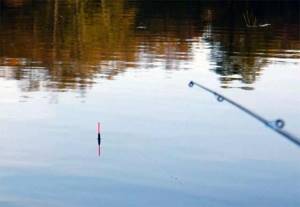
On the river
River crucian carp is much more active than lake carp, it is more interesting to catch, it actively resists when fished and bites more noticeably. It is found in creeks, near vegetation, and migrates a lot, so in order to find it, you will have to wander along the river bank.
In summer, many insects enter the river along with the tributaries and from the trees on the banks; river crucian carp also readily bites on such bait.
Usually its biting on the river is active only in the mornings and evenings, but in places where there are many active competitors in the search for food (bleaks, tracks, etc.) it may not stop active biting during the day.
On the pond
Here crucian carp can stay in one place for a long time, and that’s where it should be caught. If on a river it avoids the stormy current in the middle of the channel, then in ponds and lakes it can go to the middle of the reservoir if there is vegetation there. Then it is better to catch it using long feeder casts or from a boat.
It has been noticed that lake crucian carp in summer gives more preference to plant foods. He is inactive and less timid, but he also does not like noise on the shore.
It is on ponds that it is easier to use regular bait; it is not carried away by the current.
Fishing at night and during the day
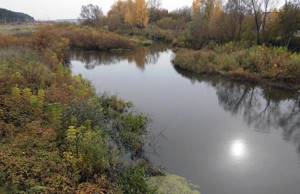
The peculiarities of daytime fishing have already been mentioned; it happens at dawn and evening hours. In early spring, crucian carp may begin to bite at all by noon, when the water warms up. But at night in spring or autumn, as a rule, he does not bite.
But in the summer, during the hot season, he can go out in search of food only at sunset. The water is getting cooler, there are fewer predators around – it’s time to swim in the pond.
Usually at this time large crucian carp come out into the open spaces and during the day they sleep somewhere in a shelter. You can catch it at this time with a regular float rod - at night crucian carp of any size without fear approaches the very shore.
Wrong nozzle
Some of the crucian carp reservoirs are listed in the “uncool register” for a long time only because the fish in them are picky, and the key to it has simply not yet been found. That is, the reason why the crucian carp does not bite is that the bait is unusual for it, and this despite the fact that on other bodies of water it can show itself very well against this fish.
Smell and taste
In the most “capricious” version, we are not even dealing with a well-fed crucian carp, but with an absolutely greedy crucian carp, accustomed to the taste and smell of the food that it usually picks up from the bottom of the reservoir. And what the fisherman slips to him, he will most likely ignore. What do the most experienced and experienced crucian fishermen do in this situation?
I don’t think that the first thing they do is start sorting through all possible baits, baits and attractants. This, of course, can help to some extent, but the best thing now is to slip under the crucian’s nose what he is used to eating. This can be either a bloodworm, or a red earthworm, or some other aquatic and semi-aquatic invertebrates, preferably caught in the reservoir where fishing is carried out, or in its environs. As a rule, crucian carp (if feeding at this moment) instantly responds to what is offered, because it smells and tastes no different from its usual food.
At the same time, in some reservoirs, crucian carp become so accustomed to a certain type of food that they bite on a single bait (for example, on the same worm). Other options - both plant and animal - are absolutely indifferent to him.
It is probably also worth mentioning baits that smell absolutely nothing, and therefore should not arouse any suspicion in the crucian carp. But this is already a section not of float fishing, but of baitless fishing (side nod, or with a winter fishing rod from a boat). And the crucian carp here bites not on bait, but on correctly selected vibrations. However, it also happens that crucian carp does not respond to an animal or plant delicacy offered by a fisherman, but is caught perfectly well with no bait.
Attractants for crucian carp
Regarding the selection of baits, this method of making crucian carp bite is also effective, but you will never guess what exactly may attract capricious fish today. But it is advisable to take as many bait options with you when fishing as possible. And don’t be shy about “playing” with attractants. By the way, it has been noticed that crucian carp can be attracted not only by the smell of linseed oil and strawberries, but also by garlic, as well as kerosene, and even WD-40 lubricant!
Fishing technique and tactics
Describing the types and assembly of gear, we have already talked a little about this. Now let's summarize the main points.
- On the killer of crucian carp.
The technique of such fishing is simple, but requires certain rules:- It is advisable to use bait in advance;
the consistency of the bait should resemble plasticine;
- Styrofoam can be used as bait on hooks;
- the worm can be used not entirely, but in small pieces;
- the rod should be equipped with a sensitive bite alarm, maybe even a sound or light one.
- For a float rod:
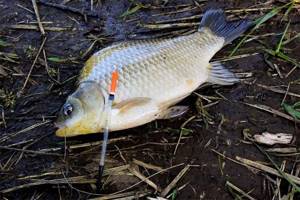
- fish should be fed before fishing;
when fishing on a pond with a large number of fishermen, bait can be used only once to initially attract fish;
- the thinner the line, the greater the likelihood of a bite;
- It is better to use pellets for sinkers; voluminous heavy tackle will force cautious crucian carp to spit out the bait;
- You can use several leashes, but at different heights to avoid tangling.
- On the donk:
- the tackle can be used in reservoirs without or with weak currents;
- it is the donka that allows you to catch large specimens in the pond, which almost do not rise to the surface of the water;
- allows you to fish in large ponds and lakes far from the shore;
- It is not advisable to use it in areas with dense vegetation.
- To the feeder:
- the proximity of the feeder and bait makes such fishing effective even when the bite is inactive;
- Initially, only feeders with a large supply of feed are cast;
- to check the gear, you should regularly check it and re-throw it;
- Additional bait is given in small doses.
- On the pacifier:
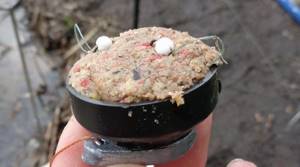
- the viscosity of the bait should be higher than usual;
some hooks can not be buried in the mixture, but placed nearby;
- hooks should be small;
- It is better to place small pieces of animal baits in the plant elements of the bait.
- Makushatnik:
- pay special attention to the freshness of the cake; its rancidity or possible smell of rotting will discourage fish;
- For crucian carp, the pieces of macaque should not be made large;
- It is better to cast from a boat.
- Spring:
- when using sliding tackle, react to the jerk, and not just to the trembling of the fishing line;
- when fishing in the current, the bait should not be washed out quickly;
- using more than 2 hooks in this gear is impractical.
- Rubber:
- It is better to lower the sinker into the water from a boat;
- just pulling on the line indicates the approach of the crucian carp, you need to wait for the jerk;
- when gripping the bait, the elastic usually softens the resistance of the fishing line, and it also softens the jerks of the fish when fishing.
Incorrectly selected gear
Typically, crucian carp weighing from 200 to 400 grams bite. Catching a large specimen over 1 kg is a real rarity. Therefore, when fishing for cautious crucian carp, gear should be light and inconspicuous. Otherwise, he may see a thick line or feel unnatural resistance when biting, because the angler uses a large number of sinkers or a heavy float when rigging.
Often, inexperienced fishermen do not know about this and try to fish with “rough” gear. For example, they use floats weighing from 3 grams, fishing line with a thickness of 0.2 mm or very large hooks that the fish cannot swallow.
Often the lack of bites can be explained by an incorrectly selected bait supply depth. Crucian carp try to feed from the bottom, and when the hook with the bait is higher, they completely ignore it.
Those who like to fish with a feeder often make the following mistakes - they make leashes that are too short and place heavy feeders, which create a lot of noise when casting and scare away the crucian carp. When fishing with bottom gear, it is also important to use the correct type of rig so that the fish can hook themselves. Otherwise, it will simply pull the bait, and the angler will not even see the bite.
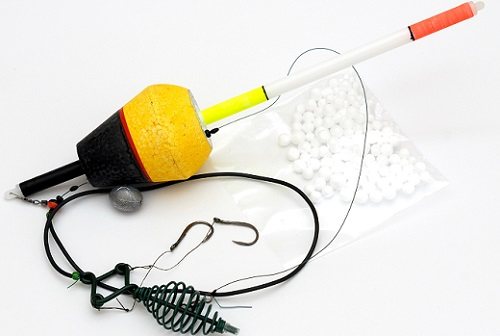
Fishing success depends on the right gear
Tackle for crucian carp
A fishing rod for crucian carp is the most common tackle, well known to all fishermen since childhood. Previously, fishing rods made of reed, hazel or bamboo were used for fishing. Simply because a good fishing rod was rare. Now the choice of gear is unusually large, and it is better to keep up with the times.
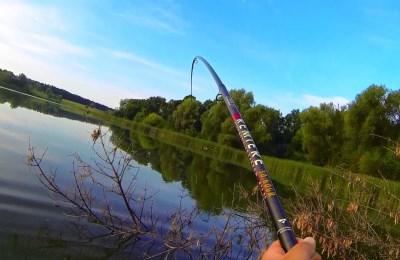
"Fishing for crucian carp"
If you need a universal fishing rod, I advise you to buy a telescopic rod, 4-4.5 m long.
There are tackles with and without rings on sale. The last option is not ours, because... imposes certain restrictions on the fishing distance.
A rod with rings will allow you to catch crucian carp both under your feet and at a great distance from the shore.
The cost of the simplest fishing rod is 300-400 rubles. For that kind of money you will get a fiberglass fishing rod. If you have a budget of 2000-3000 rubles, I advise you to buy a carbon rod. It is much lighter and is able to clearly convey all the movements of the fish when playing.
The rod must be equipped with a spinning reel, size 2000-2500 according to the generally accepted classification (Shimano). A fishing rod reel can be quite budget-friendly, because... the load on its mechanism will be minimal.
But it’s better not to buy too cheap models - they will let you down. Focus on the price tag of at least 800 rubles. The line for catching crucian carp should be monofilament.
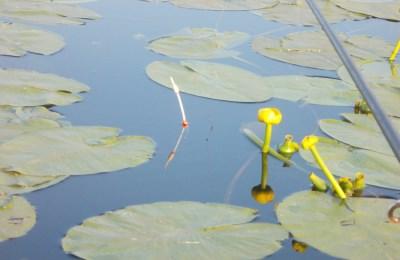
Typically, anglers choose a fishing line with a diameter of 0.2 mm as the main one.
If the situation requires the use of a thinner fishing line, you can tie a leash.
In order to make various equipment, you need to buy a set of pellet weights, mounting cambria and several types of floats.
You should have alarms for long casting, as well as regular floats for “blind rigs”. You also need to purchase several types of hooks.
The hook is the most important part of the rig. There are a lot of nuances when choosing hooks. I described all of them in detail in this article (link to the article about hooks for crucian carp).
How does crucian carp bite?
“How much people know about various nonsense, and how little about biting fish!” – one sage exclaimed this undeniable truth back in Ancient Greece. Whatever one may say, he is one hundred percent right! Quite a lot of books have been written about fish biting, but still, the secret of fish biting has not been discovered to this day. Moreover, if we talk about the bite of such a fastidious and interesting fish as crucian carp. The bite of crucian carp is an absolute mystery of nature! After all, there are cases when a fisherman very well hears the sounds of crucian carp feeding somewhere in the reeds, but still, the fish does not even approach the bait and does not show any activity. How is this explained and can this phenomenon be changed? A real mystery! For example, with experienced crucian fishermen, this fish bites almost the whole year, with other fishermen - only in very rare cases. This can be explained, first of all, by the correct choice of gear, special technique and method of fishing, and most importantly, by the appropriate behavior of the fisherman himself, who does everything necessary so as not to scare the crucian carp and force him to pay attention to the bait. Even in the most favorable times of the year - in spring and summer - the bite of crucian carp lasts only a short time, in frequent cases, from dawn until about ten o’clock in the morning. But still, even in the spring, at the height of the activity of the underwater world, crucian carp do not bite every day. If before the upcoming fishing it rained lightly for a couple of days, and then the sun came out and the weather became stable, a good bite is guaranteed! In the summer, the best activity of crucian carp moves to the earliest time. Also, crucian carp bite well in the evening, at sunset and even at dusk. In some cases, this fish is excellently caught at night, but it is not so easy to see the float oscillate at night, so many anglers prefer donks with bells. And, in the end, there are completely inexplicable cases when crucian carp begins to respond to bait in the hot summer. True, this happens either in dense grass thickets, or somewhere in the middle of the reservoir. The bites of such fish as crucian carp are well described by the fishing classic Sabaneev, who argued that the bite of crucian carp is always varied, and it does not have specific rules. We can say that crucian carp bites in a particularly quiet and unexpected way, so the fisherman should not allow premature or late hookings. Small crucian carp, as a rule, lead the bait with a float to the side, after which this movement accelerates, and subsequently completely subsides. At the moment of this certain calm, you need to make a sharp cut. Larger specimens bite like bream or tench. When a large crucian carp bites, the float shudders slightly or even jumps out, then moves to the side and falls on its side. The hook must be made at this very moment. From Sabaneev’s personal opinion, one can understand that it is very difficult to catch the moment of a successful hook. It is especially difficult to make a correct hook when the float “dances” for a long time. Oh, how difficult it is to catch crucian carp!
Lures and groundbait for effective fishing
There is an opinion in the fishing world: “without “successful” bait there will be no successful catch.” For catching crucian carp, good and high-quality bait is simply necessary. Crucian carp is not a fish that will spend a significant part of its time searching for food throughout the reservoir. But when he hears the smell of bait, he will not remain indifferent and will definitely come closer to the source of the smell. Fishermen distinguish between bait and bait. Privada is a feeding mixture that is thrown into a pond 1-2 weeks before fishing. In frequent cases, an inexpensive mixture is used for bait, which can serve as various food scraps. The purpose of the bait is to force the crucian carp to regularly visit the same place. The process of preparing bait, that is, a mixture that is thrown into the water before fishing, is more complex and sophisticated. The point of bait is to attract crucian carp to the place where fishing is taking place, but in no case to feed it. The fish should approach the place where the bait is thrown and see the bait on the hook. That is why the bait should be aromatic and attractive, but not nutritious. Modern fishing stores can offer their customers a variety of similar mixtures for successfully catching different fish in different conditions. But, unfortunately, not all of these baits are able to satisfy the desires of the fish that live in our reservoirs. In addition, they are very expensive and unavailable. That is why many fishermen prefer their own bait mixtures. Each angler can create a bait mixture according to his own recipe, following the experience gained. The process of preparing bait is creative, similar to some kind of “witchcraft”. Here it is worth considering the advice of experienced fishermen, which can be found in the relevant literary publications. For example, you can make the following bait, which will include a base, various animal and plant components, and, of course, flavors and other additives. At the initial stage, you need to prepare the base of the bait, or as it is also called the “base mixture”. The following ingredients are used to prepare the base: - “vigorous” bran (about 2.5 kg); - ground rye crackers (preferably toasted) – 1 kg; - fresh ground macadamia (about 1 kg); -1 kg of crushed Hercules flakes; -100 grams of milk powder. All these elements must be mixed in a bucket and scattered into bags that need to be sealed with tape, which will allow you to store the bait for a long time. Preparing the base is only the initial stage of creating the entire mixture. In the evening, before the upcoming fishing, you need to prepare ingredients of animal and plant origin, which can serve as ordinary earthworms, maggots and others. Plant elements are prepared as follows. One or two glasses of barley or millet cereal are poured into a thermos, after which they are filled with boiling water. Overnight, the poured cereal swells, which allows it to be used for adding to the base or for hanging on a hook. After you arrive at the pond, the pre-prepared components of the mixture must be poured into a plastic bucket, add water (necessarily from the same reservoir where fishing will take place) and mix thoroughly. After this, you can add yellow or red food coloring to the mixture, as well as aromatic substances, which can be vanillin packets or flavorings purchased at a fishing store. The best smells for preparing “successful” bait are: caramel and tutti-frutti. You can also add one or two tablespoons of sugar to the bait mixture. Next, animal and plant ingredients are added to the mixture. That's all! – the bait mixture is ready and can be used for fishing. At first, it is recommended to throw 3-4 balls of bait into the water. Then, another ball after every hour. Never be afraid to “overfeed” crucian carp – there is no such thing as too much bait. If you have made a good bait, it will only lure the crucian carp, but never cause satisfaction. Some fishermen recommend supplementing the bait mixture with boiled hemp. This contains a certain secret: the aroma of hemp seed can attract even the most demanding crucian carp, but from eating such a substance, the crucian carp only relaxes, without eating enough. You cannot feed crucian carp with various food waste, rotten porridge or edible leftovers! The bait must be of high quality and edible, otherwise you are doomed to failure! In any case, the main indicator of “successfully” prepared bait is an increase in regular bites. If the bait is really good, the fish will definitely notice it and show some interest in it.
What to do if only small crucian carp bite?
Many fishermen often complain that their neighbor on the shore is biting with large crucian carp, but he only catches small fish. To avoid this terrible injustice, you need to choose the right bait.
IMPORTANT! To catch large crucian carp, it is best to use large types of bait and completely abandon small grains. In this case, small individuals will not be interested in circling around the bait and will not be able to swallow it.
Also, special attention should be paid to the size of the hook. Small two-piece hooks will make it possible to catch only small things. But if you put larger hooks, then the fish will start to bite.
